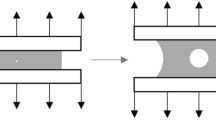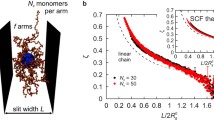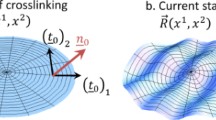Abstract
We perform exact statistical mechanics calculations for a system of elongated objects (hard needles) that are restricted to translate along a line and rotate within a plane, and that interact via both excluded-volume steric repulsion and harmonic elastic forces between neighbors. This system represents a one-dimensional model of a liquid crystal elastomer, and has a zero-tension critical point that we describe using the transfer-matrix method. In the absence of elastic interactions, we build on previous results by Kantor and Kardar, and find that the nematic order parameter Q decays linearly with tension \(\boldsymbol{\sigma}\). In the presence of elastic interactions, the system exhibits a standard universal scaling form, with \(\boldsymbol{Q / \vert \sigma \vert}\) being a function of the rescaled elastic energy constant \(\boldsymbol{k / \vert \sigma \vert ^\Delta}\), where \(\boldsymbol \Delta\) is a critical exponent equal to 2 for this model. At zero tension, simple scaling arguments lead to the asymptotic behavior \(\boldsymbol{Q \sim k^{1/\Delta }}\), which does not depend on the equilibrium distance of the springs in this model.





Similar content being viewed by others
Availability of Data and Materials
Not applicable.
Code Availability
Not applicable.
Notes
We used \(\ell ^{-N}\) in the spatial measure so that Y is dimensionless. In classical statistical mechanics, it is usual to consider the measure in phase space \(d \mu = h^{-N} \prod _i dx_i d p_i\), with the inclusion of Planck’s constant h, where \(p_i\) is the momentum of particle i. This ensures a dimensionless partition function and agreement with the classical limit of an analogous quantum system. In our case, we could combine \(\ell\) with h so that the contribution from the momentum variables is also dimensionless.
Note that Eq. (24) is valid for bulk particles. For boundary particles, \(< X_{k_i} > = (\sum _{\beta =1}^M \nu _{\beta \, \alpha ^*}X_{\beta })/(\sum _{\beta =1}^M \nu _{\beta \, \alpha ^*})\).
The average spacing s can be calculated from a derivative of the free energy as \(s/\ell = \partial (\beta f) / \partial \,\tau\). For the hard-needle elastomer, this calculation results in \(s/\ell = -(1/\lambda _{\alpha ^*}) \partial \lambda _{\alpha ^*} / \partial \, \tau + a - \tau / \Lambda\). The first term yields the expected scaling behavior, whereas the last term provides important corrections when \(\Lambda \sim \tau ^2\).
References
D.C. Mattis, The Many-body Problem: an Encyclopedia of Exactly Solved Models in One Dimension. World Scientific (1992)
S.R. Salinas, Introduction to Statistical Physics. Springer (2001)
J. Cardy, Scaling and Renormalization in Statistical Physics. Cambridge university press, (1996)
Y. Kantor, M. Kardar, One-dimensional gas of hard needles. Phys. Rev. E 79, 041109 (2009). https://doi.org/10.1103/PhysRevE.79.041109
Y. Kantor, M. Kardar, Universality in the jamming limit for elongated hard particles in one dimension. Europhys. Lett. 87(6), 60002 (2009). https://doi.org/10.1209/0295-5075/87/60002
J. Lebowitz, J. Percus, J. Talbot, On the orientational properties of some one-dimensional model systems. J. Stat. Phys. 49, 1221–1234 (1987)
J.J. Arenzon, D. Dhar, R. Dickman, Glassy dynamics and hysteresis in a linear system of orientable hard rods. Phys. Rev. E 84, 011505 (2011). https://doi.org/10.1103/PhysRevE.84.011505
R.L. Vink, The isotropic-to-nematic transition in a two-dimensional fluid of hard needles: a finite-size scaling study. Eur. Phys. J. B 72(2), 225–231 (2009)
S. Saryal, D. Dhar, Exact results for interacting hard rigid rotors on a d-dimensional lattice. J. Stat. Mech: Theory Exp. 2022(4), 043204 (2022). https://doi.org/10.1088/1742-5468/ac6038
J.U. Klamser, T. Sadhu, D. Dhar, Sequence of phase transitions in a model of interacting rods. Phys. Rev. E 106, 052101 (2022). https://doi.org/10.1103/PhysRevE.106.L052101
S.R. Salinas, On the one-dimensional compressible ising model. J. Phys. A: Math. Nucl. Gen. 6(10), 1527 (1973). https://doi.org/10.1088/0305-4470/6/10/011
D.B. Liarte, S.R. Salinas, C.S.O. Yokoi, Compressible sherrington-kirkpatrick spin-glass model. J. Phys. A: Math. Theor. 42(20), 205002 (2009). https://doi.org/10.1088/1751-8113/42/20/205002
M. Warner, E.M. Terentjev, Liquid Crystal Elastomers. Oxford University Press, Oxford (2003)
P.G. De Gennes, Possibilites offertes par la reticulation de polymeres en presence d’un cristal liquide. Phys. Lett. A 28(11), 725–726 (1969). https://doi.org/10.1016/0375-9601(69)90584-2
J.V. Selinger, B.R. Ratna, Isotropic-nematic transition in liquid-crystalline elastomers: lattice model with quenched disorder. Phys. Rev. E 70, 041707 (2004). https://doi.org/10.1103/PhysRevE.70.041707
F. Ye, T. Lubensky, Phase diagrams of semisoft nematic elastomers. J. Phys. Chem. B 113(12), 3853–3872 (2009)
D.B. Liarte, S.R. Salinas, C.S.O. Yokoi, Elastic maier-saupe-zwanzig model and some properties of nematic elastomers. Phys. Rev. E 84, 011124 (2011). https://doi.org/10.1103/PhysRevE.84.011124
D.B. Liarte, Tricritical behavior of soft nematic elastomers. Phys. Rev. E 88, 062144 (2013). https://doi.org/10.1103/PhysRevE.88.062144
D.B. Liarte, S.R. Salinas, World Scientific, Singapore p. 64 (2014)
A. Petri, D.B. Liarte, S.R. Salinas, Uniaxial and biaxial structures in the elastic maier-saupe model. Phys. Rev. E 97, 012705 (2018). https://doi.org/10.1103/PhysRevE.97.012705
T. Benmessabih, B. Bakhti, M.R. Chellali, Thermodynamics of interacting hard rods on a lattice. Braz. J. Phys. 52(4), 132 (2022)
S. Saryal, J.U. Klamser, T. Sadhu, D. Dhar, Multiple singularities of the equilibrium free energy in a one-dimensional model of soft rods. Phys. Rev. Lett. 121, 240601 (2018). https://doi.org/10.1103/PhysRevLett.121.240601
L.M. Casey, L.K. Runnels, Model for correlated molecular rotation. J. Chem. Phys. 51(11), 5070–5089 (1969). https://doi.org/10.1063/1.1671905
P. Gurin, S. Varga, Towards understanding the ordering behavior of hard needles: analytical solutions in one dimension. Phys. Rev. E 83, 061710 (2011). https://doi.org/10.1103/PhysRevE.83.061710
P. Gurin, S. Varga, Anomalous phase behavior of quasi-one-dimensional attractive hard rods. Phys. Rev. E 106, 044606 (2022). https://doi.org/10.1103/PhysRevE.106.044606
J.P. Sethna, M.K. Bierbaum, K.A. Dahmen, C.P. Goodrich, J.R. Greer, L.X. Hayden, J.P. Kent-Dobias, E.D. Lee, D.B. Liarte, X. Ni, K.N. Quinn, A. Raju, D.Z. Rocklin, A. Shekhawat, S. Zapperi, Deformation of crystals: connections with statistical physics. Annu. Rev. Mater. Res. 47(1), 217–246 (2017). https://doi.org/10.1146/annurev-matsci-070115-032036
P.M. Chaikin, T.C. Lubensky, Principles of Condensed Matter Physics (Cambridge University Press, Cambridge, 1995)
P.F. Bienzobaz, N. Xu, A.W. Sandvik, Modulated phases in a three-dimensional maier-saupe model with competing interactions. Phys. Rev. E 96, 012137 (2017). https://doi.org/10.1103/PhysRevE.96.012137
E.S. Nascimento, A. Petri, S.R. Salinas, Modulated structures in a lebwohl-lasher model with chiral interactions. Physica A 531, 121592 (2019). https://doi.org/10.1016/j.physa.2019.121592
P.-G. DeGennes, J. Prost, The Physics of Liquid Crystals. Oxford university press (1995)
S. Feng, M.F. Thorpe, E. Garboczi, Effective-medium theory of percolation on central-force elastic networks. Phys. Rev. B 31(1), 276–280 (1985)
D.B. Liarte, X. Mao, O. Stenull, T.C. Lubensky, Jamming as a multicritical point. Phys. Rev. Lett. 122, 128006 (2019). https://doi.org/10.1103/PhysRevLett.122.128006
A.J. Liu, S.R. Nagel, The jamming transition and the marginally jammed solid. Ann. Rev. Condens. Matter Phys. 1(1), 347–369 (2010) https://doi.org/10.1146/annurev-conmatphys-070909-104045
D.B. Liarte, S.J. Thornton, E. Schwen, I. Cohen, D. Chowdhury, J.P. Sethna, Universal scaling for disordered viscoelastic matter near the onset of rigidity. Phys. Rev. E 106, 052601 (2022). https://doi.org/10.1103/PhysRevE.106.L052601
Acknowledgements
DBL thanks the financial support through FAPESP grants # 2021/14285-3 and # 2022/09615-7. AP is grateful to ICTP-SAIFR for a 2-month visiting grant.
Funding
This work was partially supported by FAPESP, through grants # 2021/14285-3 and # 2022/09615-7.
Author information
Authors and Affiliations
Corresponding author
Ethics declarations
Ethics Approval
This article does not contain any studies with human participants or animals performed by any of the authors.
Consent to Participate
Not applicable.
Consent for Publication
Not applicable.
Conflict of Interest
The authors declare no competing interests.
Additional information
Publisher's Note
Springer Nature remains neutral with regard to jurisdictional claims in published maps and institutional affiliations.
Rights and permissions
Springer Nature or its licensor (e.g. a society or other partner) holds exclusive rights to this article under a publishing agreement with the author(s) or other rightsholder(s); author self-archiving of the accepted manuscript version of this article is solely governed by the terms of such publishing agreement and applicable law.
About this article
Cite this article
Liarte, D.B., Petri, A. & Salinas, S.R. Hard-Needle Elastomer in One Spatial Dimension. Braz J Phys 53, 73 (2023). https://doi.org/10.1007/s13538-023-01289-7
Received:
Accepted:
Published:
DOI: https://doi.org/10.1007/s13538-023-01289-7




